- Microwave fast drying and sintering complex morphology of porcelain and gres chamotte 0.5
Francisco Moreno Candela* and Jose Antonio Aguilar Galeab
aUniversity Barcelona
bUniversity SevillaThis article is an open access article distributed under the terms of the Creative Commons Attribution Non-Commercial License (http://creativecommons.org/licenses/by-nc/4.0) which permits unrestricted non-commercial use, distribution, and reproduction in any medium, provided the original work is properly cited.
In this research, microwave thermal processing of refractory clays is studied using minimal time. With the objective of studying the feasibility of using this technology in artistic ceramics or jewelry with complex morphologies. To do this, the differences in behavior are analyzed, in terms of heating, not only their dielectric properties according to various ceramic materials, but also confronting the differences by dimension and shape of the pieces. Once the research is completed, its viability for the area is accredited without detecting devaluations in the characterization of the sampling and with a temporary reduction of 66% compared to the conventional system, results highlight the advantages that this energy source can offer in the production of artistic models and the interest of researching it.
Keywords: Microwave sintering, Ceramics-sculpture, Artworks innovation.
The increase in the number of bibliographic entries based on the term "microwaves'' in scientific publications shows that MW (microwave) technology is, at present of interest in different areas and is the subject of numerous research studies [1]. In fact, this field of research has a long history since its beginnings date back to the mid 50's of the last century, when this possibility was already being discussed and materialized in the first experiments a decade later. Although "activity in this field began to accelerate in the mid-1970s due to the shortage of natural gas, which spurred research into microwave heating and sintering of various ceramic materials in the late 1970s and 1980s [2]. The inclusion of this technology in thermal operations has both economic and sustainability advantages because the energy is directed straight to the material of interest, whereas other systems require thermal conditioning of the cavity to heat the sample by thermal conduction [3] that is, all the air contained. But reports on complex morphologies such as those focused on artistic or artisanal ceramic specimens are limited. This difference significantly reduces the rate of consumption and processing times [4]. Sintering by microwave system substantially reduces the processing time because the energy interacts directly molecular dynamism that generates heat. However, other heating systems require sintering the sample by heat conduction. Besides this, experiments with MW confirm that the sinterability of ceramics is homogenously [5]. This system presents energetic and temporal deficiencies compared to the microwave system which also, obtains high quality sintering due to the molecular action compacting the paste in the same way as reported by multiple investigations [6].
The most commonly used techniques for the production of ceramic pieces are the kneading or direct construction by the columbin technique and throwing. There is also the possibility of casting molds with barbotine [7]. Any of these, require drying times between 24 hours to 168 hours, according to sizes and shapes, prior to the firing process, and considering an appropriate pre-drying environment [8]. A requirement necessary to proceed to a gradual heating of the kiln to dehydrate and fire the pieces (process of 7 to 12 hours of duration) in electric or gas muffle kilns [9, 10]. These ceramic infrastructures and processes can be a limitation of access and time for many artists and artisans. Electric kilns, besides being expensive, generate high energy consumption, and require a longer time to reach high temperatures (800-1200 °C). In these conventional processes, it is not possible to accelerate the heating, since the rapid removal of water can lead to a reversal of the moisture gradient and the appearance of defects associated with non-uniform moisture profiles, resulting in the best cases differential shrinkage or cracks in the pieces.
However, there are some difficulties with this technology. Depending on the material to be processed, whether or not it effectively absorbs MW energy. In the case of most ceramics, at low temperatures, they present low dielectric properties, especially when they are processed at low frequencies (less than 2.45 GHz) [11]. In these cases, long heating times of the material are required, leading to a number of process disadvantages, such as temperature gradients in the sample, exaggerated grain growth and microstructural heterogeneities. These aspects mean that the benefits normally obtained from harnessing MW energy are not achieved [12].
In this research, a drying and firing method adjusted to the time limit was carried out for recently kneaded semi-wet ceramic pastes. Some researches have reported that the utilization of MW for drying processes shows a fast and efficient operation [13-15]. The total or partial separation of the liquid contained in a material is a phenomenon that is generated with excellent effectiveness under MW, especially when this liquid is water, causing a dielectric heating due to its dipolar nature that, added to the high frequency of the exposed electric field, produces a realignment at a 1,000,000/s, causing the internal friction of the molecules that generate the heating of the material [16]. Consequently, MW drying is caused by the absorption of energy by liquids. The properties of water produce dielectric heating during the exposure of the object to the electromagnetic energy (250 MHz-2.45 GHz), leading to evaporation and, as a consequence, drying [17]. In the drying phase a selective heating takes place, due to the fact that the wave absorption is higher and, therefore, more effective in areas with high humidity, obtaining an intense, uniform and quality dehydration [18]. Some studies have shown a 33 % reduction in drying times with respect to conventional heating for common reddish clays (composed of: Al2O3-2SiO2-2H2O) [19]. These statements do not discriminate against various shapes such as those commonly used in sculpture or jewelry. Clarifying if these advantages are applicable to these areas are the reasons that motivate this study.
Following the intensive drying MW process (hereafter IDMW), high temperatures (900 to 1280 ºC) need to be generated for the sintering of the samples. However, evaporation complicates the possibility of heating since the dielectric properties are lost, requiring catalytic materials that allow further increase in temperature with MW. For this reason, hybrid MW heating was used. The catalyst material (high absorber MW) transmits temperature by conduction to the sample, again enabling its heating. To carry out the operation, it is necessary to take into account the depth that reaches the MW radiation in the susceptor material (or catalyst MW) that will perform the transformation from electrical to thermal energy. It varies depending on factors such as; electrical and thermal properties, size and density of the body. So, the way to apply a susceptor to the sample to assist the temperature rise until firing is determinant. In this research, (three) MW muffle formats have been built according to the needs of the samples. This complexity generates an unknown variable that the MW pose, the morphology of the samples interferes in the interaction of the waves, both in the drying process and the sintering process. It is for these reasons that the research focuses on morphological analysis. For this purpose, (four) morphologies have been designed covering simple, semi-complex and complex shapes.
Therefore, this study aims to contribute to the optimization of ceramic processes through the advantage of MW (microwave) technology, specifically to those of artistic orientation that use complex and varied morphology. The reports oriented to their application in these areas are limited, resulting in the importance of analyzing the performance in morphologies of various parts such as those commonly used [17]. The research sets two objectives. On the one hand, rapid drying without the appearance of deterioration in the sample. On the other hand, the samples are then sintered using a hybrid MW heating approach (hereafter HMWH).
To control the heating of the samples, MW time/power are calibrated. First the samples are irradiated for intensive drying (hereafter IDMW). During this process, the heating is brought to the limit that allows the samples to be kept intact by applying the trial/error strategy. Subsequent HMWH treatment is then carried out. The IDMW and HMWH systems are correlated by assessing their effects on each other. Indeed, the implementation of the IDMW process has the potential to significantly improve the structural and mechanical conditions of the samples, which in turn optimizes the HMWH process making it more efficient in terms of durability and characterization. These qualities are analyzed and demonstrated in a 2018 study on a ceramic composite of Al2O3-SiC ceramic composite, which concludes that, in addition to the postulated advantages of immediacy of processing and consequently the logical energy efficiency, the samples analyzed show higher density, uniform grain formation in the micro-sintering uniform grain formation in microwave sintering compared to conventional sintering, resulting in a final product of higher hardness and toughness that is higher hardness and toughness with higher resistance to fracture [20]. Fig. 1, 2, 3, 4
In parallel, morphology analyses (general and superficial volumetric variations of the section and mass), as well as the conformation of the samples and the composition of two pastes are combined. The calibration of heating curves was designed for minimizing to the limit the time needed for processing. In addition to temperature, quality indicators such as spalling, cracking or explosions on the samples are monitored during the IDMW stage. Silicon carbide was used as the electromagnetic. As for the characterization of the sintering, density, immersion, mechanical properties and photographic (Fig. 5) indicators are monitored. To calculate the shrinkage of the samples after sintering, they were introduced again into the mother mold. In addition color is interpreted in such a way that: white indicates a complete sintering, dark gray, bone white or ocher incomplete sintering (or biscuit), while light gray is related to an inferior thermal process with the two previous cases.
Instruments and Sampling
The devices used were Becken BA-63F7 MW-1000 W nominal power. Output 750 W. Frequency 250 MHz-2.45 GHz wavelength of 122.4 mm. A device with 7 power settings [105, 270, 300, 350, 525, 600 and 750 W]. As a temperature measuring instrument in the IDMW stage, the Infrared Thermometer F-62 MAX-PLUS (measuring range -30 °C to 600 °C) positioned at 350 mm from the samples at an angle of 90º was used.
For the HMWH stage, a RS-42 pro digital thermocouple, RS calibrated, with 1 channel for type (k) probes, accuracy: ±0.5% + 1 °C, ±0.5% + 2 °f, was used.
The samples were subjected to a preliminary hot air flow drying process (hereafter PDAF) using a TROTEC TDS 19E 3RW machine at maximum power. The number of samples made was determined according to the settings required to ensure the operation of the IDMW and HMWH processes.
The preparatory sampling resulted in a total of 39 samples covering 4 models and 2 construction techniques:
-(13) simple forms "Cylindrical", chamotte (B.G. 0-5), mineralogy: SiO2 59.97, Al2O3 29.38, Fe2O3 1.29, CaO 0.16, MgO 0.24, Na2O 0.15, K2O 1.35 and TiO2 1.50. Squeeze-molded form (11.75 g weight). Sintered by muffle B.
-(17) semi-complex shape "Fangs", porcelain mineralogical: SiO2 63.00 Al2O3 25.29, Fe2O3 0.32, CaO 0.38, MgO 0.14, Na2O 1.84, K2O 0.87, TiO2 0.10 Loss of ignition at 1000 ºC 8.08. Shape obtained by slip casting (3.7 g). Sintered by muffle A. Barbotine was 1600 to 1700 g/l of water. The demolding elapsed 3’30’’.
-(10) complex "Bell", porcelains, same as above, shape from mold (12.6 g average weight). Sintered by muffle B (same as the Cylindrical).
-(9) complex forms "Basket", chamotte same as above, equal to the first one, form kneaded by squeeze (224 g weight). Sintered by muffle C.
Microwave Treatment
Intensive Microwave Drying (IDMW) it is the initial phase of processing; the drying curve is adjusted to the maximum dehydration point indicated by constant weight and temperature of the sample. The IDMW takes care of moisture removal in the shortest possible time in a safe manner. The MW power is stepped to avoid temperature gradients in order to control excessive grain growth and microstructural heterogeneities [21]. The curve ends when the material has lost its dielectric properties due to dehydration [22]. Events reported in other studies with similar processes. If waves continue to be emitted in the cavity, there is a risk of damaging the magnetron. During the process, temperature measurements are made by infrared, taking advantage of the patterns between the different power levels in each curve. This action favors the application of a intermittency in the power supply (hereafter IMW). This contributes to a gradual and controlled heating avoiding thermal avalanche. A measure applied with the exception of the curves that present steps of 1’ duration, so as not to interfere with the thermal progression generated in the sample. All of them are positioned in the central part at 350 mm at an angle of 90º.
Hybrid Microwave Heating(HMWH) this stage is intended to assist the thermal progress to sintering. The dielectric properties of the ceramics at high temperatures become effective again, absorbing MW another time [23] and [24] and C. To do this, samples are introduced into a susceptor muffle, which absorbs and retains energy to help the sample regain its absorption [25]. The challenges associated with the sintering process can be intensified if high irradiation powers are used for the purpose of compensating for the low dielectric losses of the material in the early stages [26]. This could lead to significant temperature gradients, activation of gases present in the chamber, formation of electrical discharges, thermal buildup, crack formation, and even destruction of the sample [27]. These reasons justify the approach again of caliber time/power until performing thermal processing that meets the objective of reaching and maintaining sintering temperatures between 980-1280 oC.
Three MW muffle formats adapted to each specimen were used. Since the muffle chamber favors conductivity in the sample, they were constructed according to their size. Temperatures were recorded by inserting a thermocouple probe inside the muffle chamber to a depth of 5 mm. The key lies in the combination of a microwave-transparent material that acts as an insulator and is highly refractory. Inside is a lining made of MW absorbing material. This coating surrounds the empty space where the sample is placed, being responsible for generating the required temperature. This combination allows the microwaves to pass through the first material until they meet the susceptor, which in turn absorbs the electrical energy, transforming it into thermal energy. Due to the high refractory properties of the MW transparent material, the energy is retained and transmitted to the sample by conduction.
The muffles were manufactured with low density refractory. Their composition is Al2O3 67% and SiO2 30.05%. For its creation, the bricks are modified according to the desired cavity to be created, circular, square or rectangular, in such a way that it generates a hollow chamber in its interior to house the sample. To act as a susceptor, a coating with a thickness of 0.85 to 1.2 cm is applied (140 µm) bonded with 5% bentonite to ensure surface vitrification of the susceptor layer. The muffles are provided with a hole as a sight glass to observe the inner incandescence.
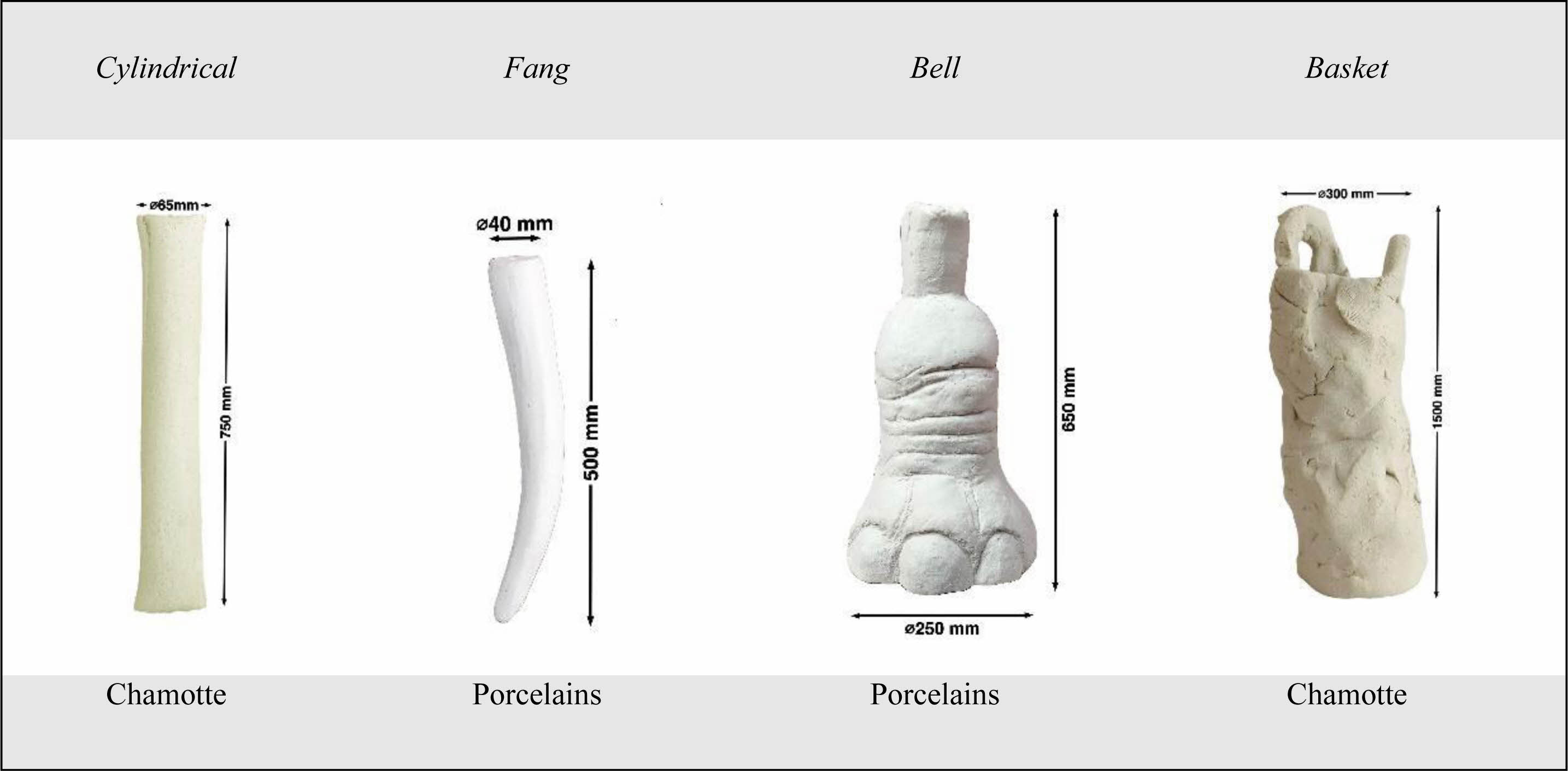
|
Fig. 1 Test tubes: Cylindrical, Basket and Fangs, Bells from left to right. |
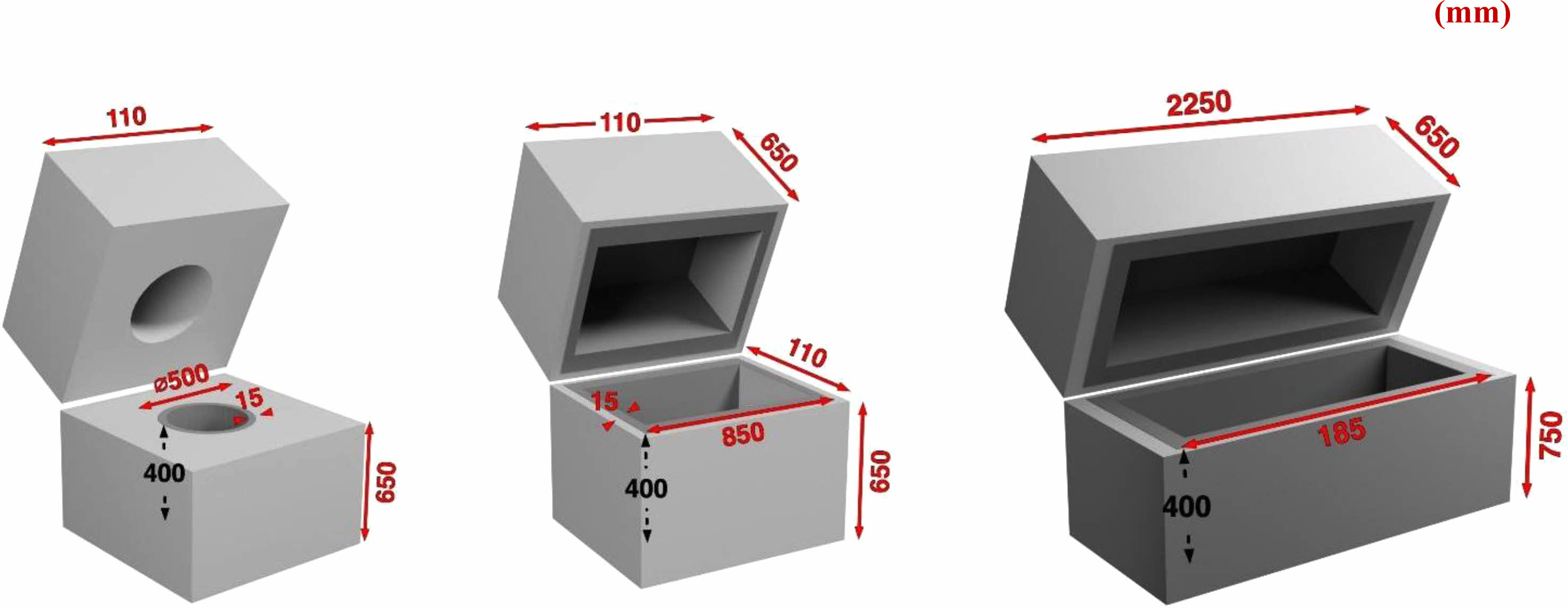
|
Fig. 2 Models 3-D: Muffle A (2.a) (1205 g Al SiC/ 140 g SiC); Muffle B (2.b) (1245 g Al SiC/195 g SiC) and Muffle C (2.c) (2321 g Al SiC/685 g SiC) from left to right. |
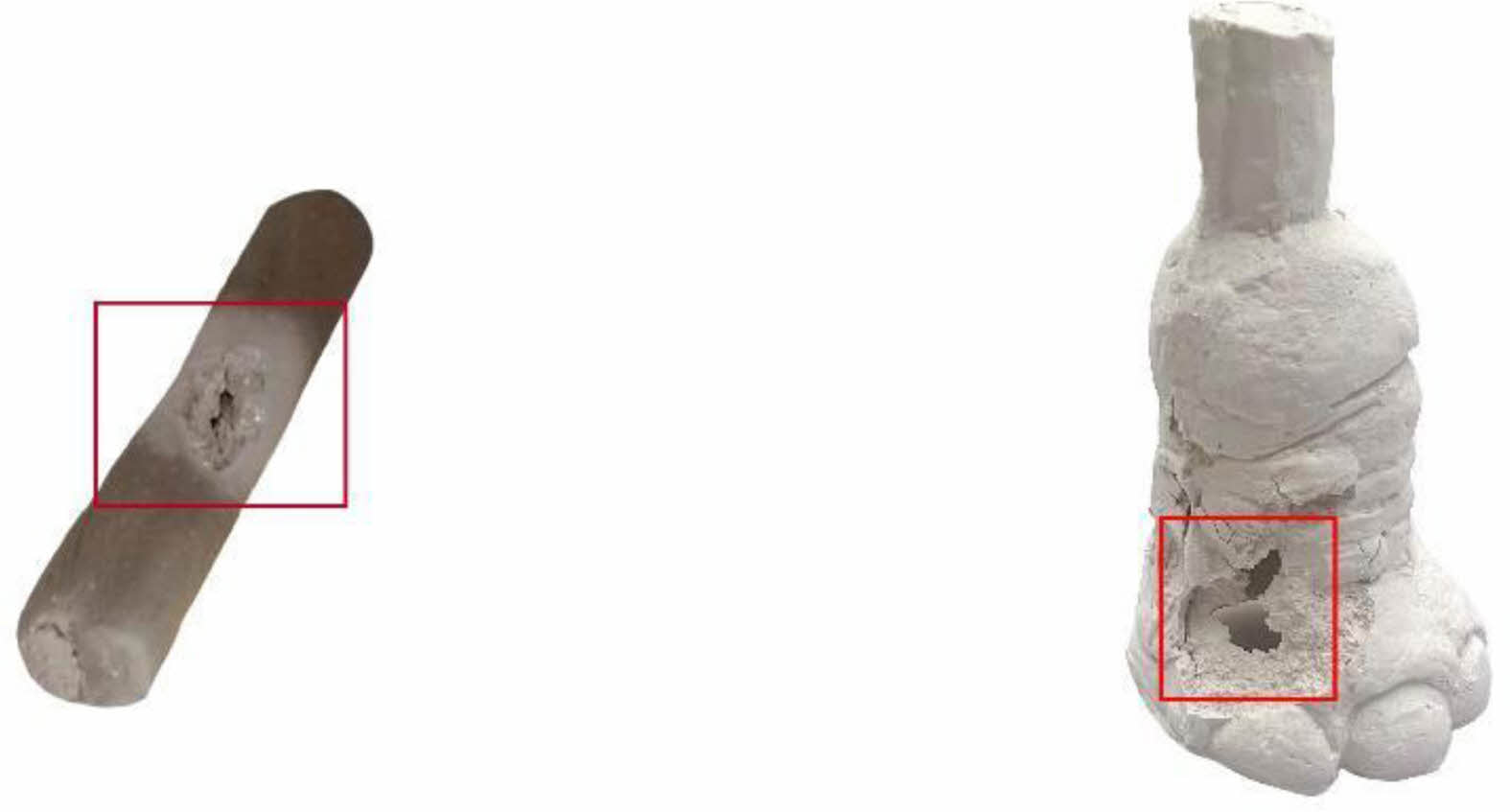
|
Fig. 3 Damage due to model breakage Cy2 and Be4 from left to right. |
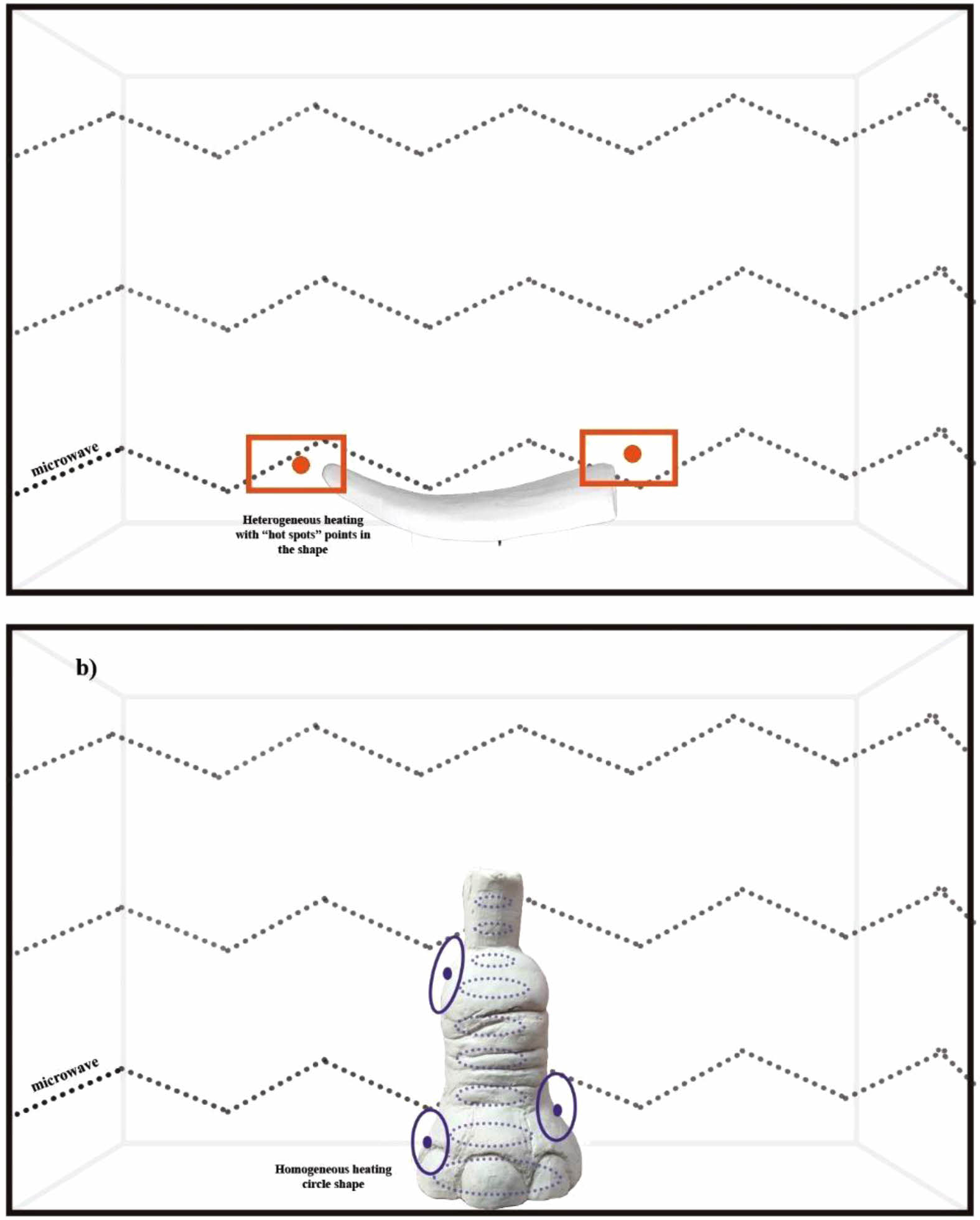
|
Fig. 4 Compares irradiation by morphology model Fa and Be. Shown from left to right: Fangs sample with hot spots points in color red. And Bells with homogeneus heating in color blue. local deterioration due to aggressive heating. |
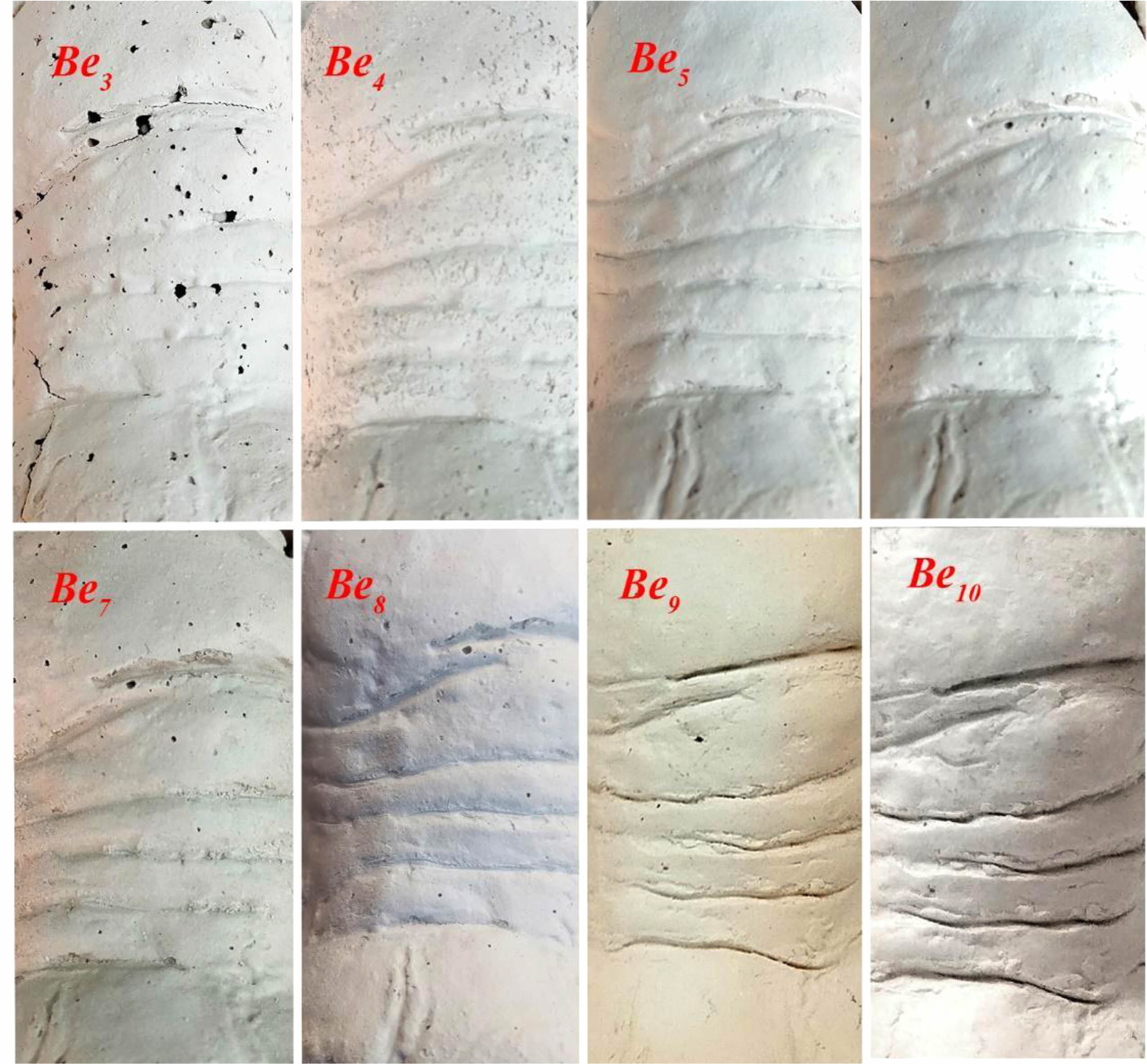
|
Fig. 5 The mosaic shows (X1) Be3-10 The first row compares the textures resulting from different IDMW processes. Abrasion is seen in the first and two samples. The second row shows the sintering results: peryflastics deformation and chromatic heterogeneities, in the third sample an ocher color can be seen due to the lack of maintenance temperature. The last one shows the complete sintering and with a correct HMWH process. |
Intensive Microwave Drying (IDMW)
In the first group of tests called Cylindrical,a high rate of sample destruction was obtained, which is why a hot air flow was used prior to MW drying (hereinafter PDAF). The PDAF makes it possible to reduce the high humidity on freshly kneaded samples and consequently the sample deterioration in the MW device. The PDAF column in Table 1 indicates how to calibrate the time until the IDMW system can be effectively started for the different tests. In the same table, in the column "Time" theelapsed MW time for the appropriate IDMW is reflected. It is observed that, up to sample Cy6, the remaining samples deteriorate irreversibly. Only after 13' at 105 W the samples admit an increase in MW power because, during the drying process, the abrupt release of water vapor causes deterioration in the simples evidencing extreme sensitivity to radiation of Cy group. In addition, for proper IDMW it was necessary, starting with sample Cy6, to apply MWI (microwave intermittency), which allows to control the temperature rise.
The required PDAF setting is shown in Table l. 10 hours of hot air at 32 °C to effectively dry in the case of Cy. samples. The PDAF duration determines the moisture presetting required for the IDMW process performed in the MW. The adjustment is established starting from sample Cy9. Starting with sample Cy9 the first step of the curve [13' at 105 W] records a moisture removal dehydration of -0.554 g [sample temp. 32 to 59 ºC]. The continuation of the next step of the curve [6'-270 W] and with an IMW of 2' in between, records -0.162 g [sample temp. 59 to 78 ºC]. With this staggering, progress is made without uncontrolled gradient recordings or deformations in the sample. The IDMW curve [Cy9-13] with an average removal of -0.816 g is established as safe.
In the group of tests Fangs, the column "Sequence" reflects less sensitivity to deterioration, in addition to the number of samples necessary to reach the appropriate caliber. The previous experience of the PDAF and IMW applications as a solution to reduce deterioration of the Cylindrical sampling. From the interpretation of the results shown in Table 1, starting from sample Fa4, it is operated without deterioration [10'-105 W; 10'-270 W; 5'-350 W]. The adjustment is established starting from sample Fa11. At this point, the sample's show benefits from starting IDMW treatment at 270 W. The curve [5'-270 W; 1'-300 W; 5'-350 W; 1'-525 W; 1'-600 W] indicates a decrease per dehydration of -0.512 g.
The results obtained in the Fangs test reflect a more efficient IDMW than the predecessor group of samples due to the increase in capillaries as a result of the creation of the sampling by the barbotine method. Test Fangs indicates how from sample Fa4 onwards, the PDAF (6 h) is regulated. The design of the IDMW curve is from sample Fa13-17. This approach allows subsequent power increases without deterioration, enabling a controlled extension process without risk of furnace overheating or damage to the samples. These results demonstrate the importance of an accurate preparation process for effective MW drying and treatment of ceramics of various shapes and concrete data to apply to the following samples. Clay objects obtained through a casting mold, unlike those pressed, show greater transparency to microwaves, allowing the early boiling of their contained water to be controlled, in addition to facilitating its evaporation between capillaries [28].
The Be5-10 curve removes -1.182 g of humidity, requiring an IMW operation of 3’ per step in order not to deteriorate the sample. Again, the increase in capillaries due to not being pressed samples. These results are a consequence of the execution technique, the paste is less compact, so the probability of abrupt release of water vapor is lower.
The following illustration compares the differences in MW uptake. In 2nd place, the shape of the samples, which are concentrated in the horizontal plane, captures the irradiation in a more punctual way, generating areas of intense heating known as "hot spots",unlike the "bell" shape, which has a wider and more spherical surface, favoring the convection of the heat. In relation to the MW pickup, the waves are only absorbed occasionally by the lying shape in a less homogeneous way, the upwards bell shape absorbs on more points of its surface, heating more homogeneously. It absorbs more waves at the same time. In addition to this, as normal heating, the bell, being a hollow shape, and cylindrical, contains an air chamber inside that favors its heating in all its internal surface, running through the piece without tension. However, since the fangs are pointed, they absorb energy on the tip.
The last test,examines the Basket morphologies. In the first instance, greater susceptibility to deterioration is observed in comparison with the porcelains: Fa and Be. This cause is due to the increase in size of the sample formats (>712 g) and, therefore, of centiliters of water and MW absorption. The increase in water content requires further control. Table 1 shows how from sample Be5 onwards it is necessary to increase the IMW by at least 4' by fractionating the min power. If operating at continuous irradiation, irreversible thermal avalanches are produced for the state of the sample, even exceeding the boiling point in certain instances. This scenario causes an abrupt release of water and consequently explosions due to the sudden evacuation of steam.
The heating curve [Ba5-9] was established as safe, resulting in an average removal of -15.662 g. For the 270 W to 350 W range, the table shows constant weight and temperature, which means that the largest percentage of water has previously been evaporated. Corresponding the remaining to pore and chemical water. As clarified previously with these indicators the IDMW curve is concluded to avoid overheating of the furnace. As the last steps guarantee the correlation to the subsequent thermal process in the MW muffle. The moisture removed per unit of time depends on the IDMW, decreasing from 6.991%. The results of the Ba1-9 samples attest to the performance of the method (IMW) as a safe method to guarantee the IDMW system in medium-sized pieces. The MW intermittence is a safe method of drying in ceramic pieces of relative size and recent preparation that always involves a temporary shortening of the processing.
Always keeping in mind that one of the main objectives of the proposed methods is the temporal reduction of processing, the challenges solved for extruded clay objects have been to minimize prior drying and manual microwave intermittency. However, it is relevant to take into account in this investigation that the multiplication of bodies in the same cavity would not only increase the number of samples processed but would reduce the strategies of PDAF e IMW.
The series of results described in the different groups of samples show how the indicators established in the research identify differences in the density of the material, the shape of the samples and the mineralogical composition. The composition of the ceramic paste has a significant impact with the results. In the case of the Cylindrical samples, the chamotte used has 1.29% Fe2O3, while in the "Bell" shaped samples,the porcelain used has 0.32%. This disparity in the Fe2O3 content is relevant in IDMW because it is a susceptor material, acting as a kind of "ferrite" highly absorbent of electromagnetic fields. Ferrite is a highly electromagnetic mineral that absorbs microwave energy at cavity temperatures instantly. This condition uncontrolls the progressive heating, requiring an optimization of the IMW system with longer intermittency intervals [29]. Resulting in unbalanced temperature gradients, especially in the case of the former, when working with short time intervals [30]. A different behavior was detected due to the mineralogical component obtaining higher rates of sample destruction in the chamotte pastes [31].
The distribution of waves is more regular when the body to be heated covers a greater surface area in the oven cavity. The rounded shapes prevent the appearance of hot spots. They appear in sharp areas and generate thermal stresses that favor cracking [32].
In terms of sintering quality and optimization of hybrid microwave heating on complex and semi-complex shapes, this reserch has shown that high quality characterizations are obtained, without devaluations or deformations that could interfere with the shape and texture of the artistic pieces. Examples of this are simples “Falls” and the detailed textures without undesired reactions on the surface of the “Bells” samples.
Hybrid Microwave Heating (HMWH)
It is considered that, at low temperatures, the molecular interaction with the dehydrated pastes at the end of the IDMW process is low or non-existent [33]. When their water content evaporates, they lose their dielectric properties. A second heating stage is carried out to continue heating up until sintering. The sample is dried, introduced into the MW muffle which will absorb MW energy and will be transmitted to the sample by conduction. To design new MW time/power curves, the temperatures recorded by the thermocouple probe and the observation of incandescence of the sample were used as reference. Preliminary tests justified the relation and necessity of the IDMW before the HMWH. That is to say, it was checked if the samples could be dried and fired directly inside the MW muffle, obtaining a high % rate of destruction of the semi-wet samples inside the MW muffles. The first samples showed deteriorations due to a previous application of the IDMW process that was too short, which underlines the importance of properly adjusting this stage to achieve an optimal result in the sintering process. As a sintering parameters, once the heating permissiveness of samples brought to maximum density (IDMW) has been analyzed, subsequent hybrid microwave heating (HMWH) is applied using the samples that were found to be successful. In the case of the Cy group, an effective sintering curve is established starting from Cy9. In particular, to sinter 11.75 g chamotte models, a 12' at 166 Watts/min with the curve [3’-525 W; 3’-600 W; 6’-750 W] was used.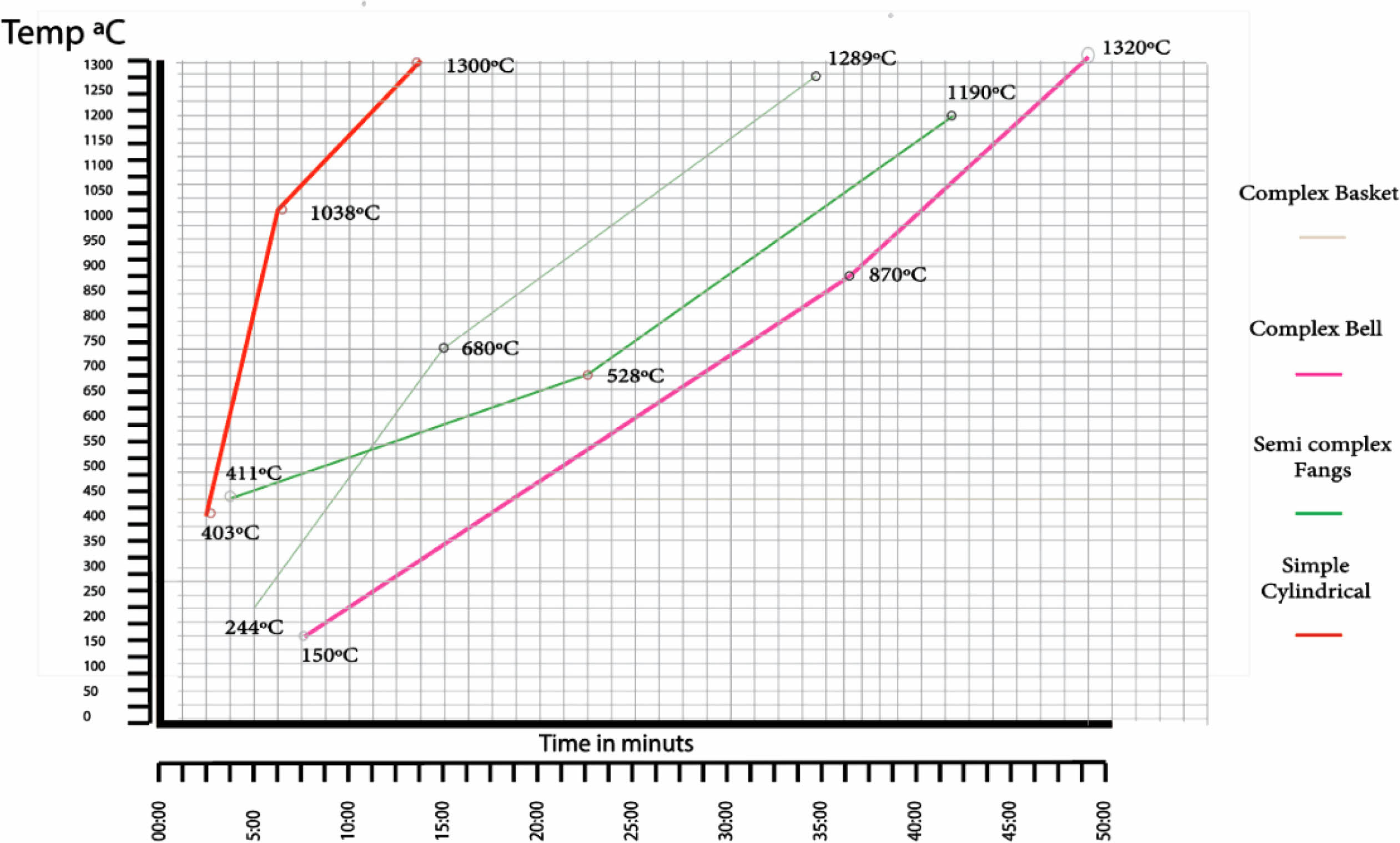
Graphics. 1. Comparative microwave sintering curves of each model.
In Table 2, the sinter results for Fangs showed a density increment (hereinafter DI) recorded by sintering of -0.3351 g.
Sintering quickly and efficiently in the muffle A reaching incandescence rapidly (at the same time as the carbide), and obtaining optimum results in relation to the firing characterizers, as sintering parameters high quality indicators: color, immersion and mechanical properties. In less than 8’, pairs of samples of 7.5 g of porcelain achieve a successful sintering process, without deformation. The effectiveness of this sintering process is attributed to two causes: The 1st cause, an optimal prior application of the IDMW applying a long drying curve and finalized dehydration. The 2nd a proportional balance with the size of the flask cavity A. This contributes to efficient and fast heating, bringing the material to an incandescent state in a short period of time. The temperature rise cycles during the sintering process were 265 ºC/min, with a power of 669 W/min. This ease of sintering is due to good dielectric properties of the paste at high temperatures. This result is highlighted as the porcelain doesn't experience uncontrolled pyroplastic deformations and thermal leakage, unlike what has been reported by other investigations on this material. This behavior is associated with the formation of a considerable amount of liquid phase at high temperatures, which will absorb MW energy more strongly than other phases present in the sample, leading to an increase in the temperature of the system, with the melting of even more material and a decrease in the viscosity of the liquid phase. The heating curve, both in the IDMW and HMWH stages, demonstrated adequate control to avoid this type of problem, thanks to the rapid heating which reached temperatures above 1150 °C.
Bells at the muffle B start the HMWH at a temperature after the IDMW of 88 ºC and using a relative power of 700 W/Min. An optimum success rate is obtained as there are no cracks or pyroplastic deformations. After the HMWH process, a DI of -0.808 g was observed with a thermal growth of 190 ºC/min.
The Basket group morphologies show that there is no explosion rate due to good dehydration during the IDMW process. These samples, in confrontation with the cylindrical ones and/or the fangs,have a more proportionate volume for the microwave cavity, favoring the reception of waves in a more homogeneous way than the previous ones during their drying. This results in excellent volumetric MW heating in the IDMW stage, which has positive repercussions in the subsequent HMWH stage. As a result, basket model pieces are sintered with 44' per MW inside the muffle C. The significant increase in time required is exponential to its volume.
The intensive microwave drying (IDMW) is effective and significantly reduces the processing time. The comparisons carried out indicate important heating differences between artistic models made by the squeeze technique and barbotine from molds. The latter being more compatible with the IDMW operation due to greater number of more open and separated capillaries. On the other hand, extruded samples present greater MW drying difficulties experiencing a higher rate of abrupt water vapor release. These types of samples pose a higher risk of destruction. However, the methods used in this research: use of additional hot air flow (PDAF) prior and intermittent heating intervals (IMW) are safe to ensure IDMW operations on samples of complicated morphologies and Fe2O3 mineralogy > 0.32. It is important to highlight the challenges that MW presents. It was observed that chamotte samples with high percentage of ferrite experienced irreversible reactions in a short period of exposure, indicating extreme sensitivity to treatment and the need of convenient IDMW study to each sample. So it is important to consider that if too short, the IDMW process complicates the HMWH heating stage, where the probability of grain flaws and deformations is increased. PDAF and IMW systems are an efficient alternative to drying complex morphologies.
In terms of sintering, the time reduction compared to the conventional system was 66%. The study obtained sintering of complex and semi-complex shapes without characterization devaluations thanks to the optimization of the IDMW and hybrid HMWH heating systems.
- 1. Leiser, K. S. and Clark, D. E. “Theory and application in materials processing”. Ceram. Trans., Microwaves. Westville, E. A. Lewis, Am. Ceram. Soc. (2011).
- 2. R.R. Menezes, P.M. Souto, and Ruth H.G.A. Kiminami, "Sintering of Ceramics - New Emerging Techniques" (IntechOpen, 2012) p. 626.
- 3. R.B. Martinez, "Development of advanced ceramic materials with high performance through unconventional techniques" (Polytechnic University of Valencia, 2015).
- 4. C.C. Ramirez, J.I. Tobon, and C.P. Garcia, Latin American Journal of Metallurgy and Materials, 33[2] (2012) 316-322.
- 5. Z. Huang, M. Gotoh, and Y. Hirose, J. Mater. Process. Technol. 209[5] (2009) 2446-2452.
-

- 6. Y. Ju, Y. Zhu, H. Zhou, S. Ge, and H. Xie, Energy Rep. 7 (2021) 523-536.
-

- 7. P.V.J. Angel, "La lucha por el reconocimiento de los oficios artisticos y la escuela Massana de Barcelona. El caso de los esmaltes, la ceramica y la joyeria". Universitat de Barcelona, 2017).
- 8. R. Honorato Piva, P. Vilarinho, M. Raymundo, M. Fiori, M.A.R. Klegues, O. Montedo Ceramic Inter. 39[7] (2013) 7323-7330.
-

- 9. M.A. Janney, and H. D. Kimrey, “Sintering of advanced ceramic” Ceram. Soc Ceram. Trans., 1990) 382.
- 10. F.R. Sias. "Lost-wax casting: Old, New, and Inexpensive Methods" (Woodsmere Press, 2005) p. 202.
- 11. S. Chandrasekaran, S. Ramanathan, and B. Tanmay, Food Res. Int. 52[1] (2013) 243-261.
-

- 12. J.X. Tong, Q.L. Zhang, H. Yang, and J.L. Zou, Mater. Lett. 59[26] (2005) 3252-3255.
-

- 13. A Feteira, and D.C. Sinclair, J. Am. Ceram. Soc. 91[4] (2008) 1338-1341.
-

- 14. W. Sutton, M.H. Brooks, I.J. Chabinsky, and W.W. Ho, “Microwave processing of materials I” (Materials Research Society, 1988) pp. 124-137.
-

- 15. Forcada, B. B. Sagastibelza. “Microwave-assisted drying applied to fruits: comparison with conventional hot air drying” (Universidad Pública de Navarra., 2018).
- 16. C. Cárdenas, R. Restrepo, J. García, J. Marín, and C. Garcia, “Microwave as an alternative for drying materials” (Universidad Simon Bolivar, 2009).
- 17. S. Takashi, Y. Masaki, H. Yuji, and W. Koji, “Rapid microwave drying for slip cast bodies (National Institute of Advanced Industrial Science and Technology(AIST), 2006).
- 18. J. Pozos, F. Flores Galindo, N. Juárez Rodríguez, and A. Luna Castellanos. XXVII Congreso Instrum, C. S. M. (2012) 29-31.
- 19. M. Mohankumar and P. Gopalakrishnan, Bol. Soc. Esp. Ceram. Vidr. 58[1] (2019) 14-22.
-

- 20. J.D. Pittsburgh, and K. Chabinsky, "Materials Research Society Symposium" Proc. (Materials Research Society, 1988).
- 21. D.E. Clark, Microwaves: Theory and Application in Materials Processing III (American Ceramic Society, 1995) p. 592.
- 22. M. Hotta, M. Hayashi, M.T. Lanagan, D.K. Agrawal, and K. Nagata, K, ISIJ Int. 51[11] (2011) 1766-1772.
-

- 23. G.P. Lyra, V. Santos, E.M. de J. A. Pallone, R.H.G.A. Kiminami, B.C.D. Santis, J.A. Rossignolo, Int. J. Appl. Ceram. Technol. 18[3] (2021) 705-715.
-

- 24. J.M. Haussonne, Rev. Met. Paris, 99[12] (2002) 1051-1071.
-

- 25. K.S. Kim, S.S. Heung, S. Kim, and S.O. Yoon, J. Ceram. Process. Res. 11[1] (2010) 47-51.
-

- 26. J. Yi, S.N. Burokur, G.P. Piau and A. de Lustrac, J. Opt. 18[4] (2016) 044010.
-

- 27. S.B. Narang, and I.S Hudiara, J. Ceram. Process. Res. 7[2] (2006) 113-116.
- 28. S.B. Narang, and S. Bahel, J. Ceram. Process. Res. 11[3] (2010) 316-321.
-

- 29. I. Pérez-Conesa, J. Fayos-Fernández, J.A. Aguilar Galea, J. Monzó-Cabrera, and R. Pérez-Campos, J. Microwave. Power. EE. (2022) 201-215.
-

- 30. J. Fayos, C. Pérez, C. Monzó, S. Pino, and J.C. Albaladejo. AMPERE Newsletter Editor. 9[5] (2018) 2-8.
- 31. E.A Maguire, and D.W. Readey, Amer. Ceram. Soc. Bull. 57[6] (1978) 565-567.
- 32. M.N. Rahaman, "Ceramic processing" (CRC Press, 2007) p. 473.
-

- 33. M. Barsoum, "Fundamentals of Ceramics" (CRC Press, 2019) p. 648.
-

 This Article
This Article
-
2024; 25(3): 465-473
Published on Jun 30, 2024
- 10.36410/jcpr.2024.25.3.465
- Received on Nov 23, 2023
- Revised on May 9, 2024
- Accepted on May 9, 2024
 Services
Services
Shared
 Correspondence to
Correspondence to
- Francisco Moreno Candel
-
University Barcelona
E-mail: pamorenocan@ub.edu - E-mail: pamorenocan@ub.edu








 Copyright 2019 International Orgranization for Ceramic Processing. All rights reserved.
Copyright 2019 International Orgranization for Ceramic Processing. All rights reserved.